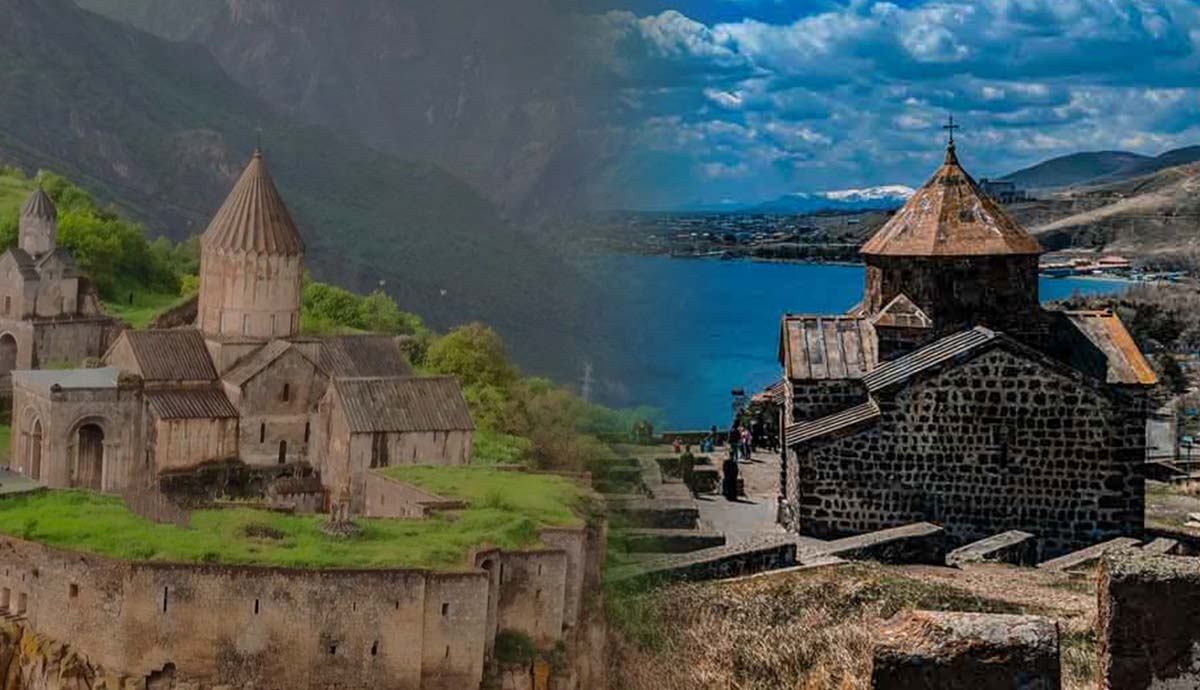
www.thecollector.com
5 Amazing Monasteries You Can’t Miss on a Road Trip Through Armenia!
Armenia is a country with impressively poor road infrastructure. A road trip through the country is only suitable for the intrepid, strong-boned, good-humored traveler. However, when viewing the incredible architecture found at just one of the 4,000 monasteries in Armenia, your worries will slip away and the views will soothe those achy bones!
The History of Christianity in Armenia
Intricate stone carvings at Noravank Monastery. Photograph: Ashley White, 2022
Armenia, a land rich in history and Christian heritage, boasts over 4,000 monasteries, making it a paradise for those interested in religious and historical architecture, but first, we need to understand a little more about the history of Christianity in Armenia.
Armenia became the first nation to adopt Christianity as its state religion in 301 CE, and locals are very proud of this fact. This decision has significantly influenced Armenian culture and identity for over 1,700 years. Early Christian communities were established in Armenia around 40 CE by the apostles Thaddeus and Bartholomew and have continued to the present day.
It is even thought that Noah’s Ark landed in Armenia on the top of Mount Ararat (although that land is now owned by Turkey). Many hotels, alcoholic drinks, shops, and souvenir shops boast the name “Ararat” because of the nationwide belief that Noah, along with all his animals, landed there.
Ararat Brandy Barrels at the Yerevan Brandy Company, photo by Veni Markovski. Source: Flickr
Two figures, King Tiridates III and St. Gregory the Illuminator, were instrumental to the adoption of Christianity in Armenia. After Gregory’s father assassinated Tiridates’s father, Gregory was imprisoned for 13 years in Khor Virap. He survived on bread provided by a Christian widow who had visions directing her to do so. When Tiridates went mad, his sister had a vision that Gregory could heal him and therefore convinced Tiradates to release Gregory. After Gregory’s release and successful prayers, Tiridates was healed from his madness and then converted Armenians’ state religion to Christianity in 301 CE.
Currently, about 94% of Armenians belong to the Armenian Apostolic Church, a branch of the Orthodox Church directly linked to the early apostles Thaddeus and Bartholomew. The Armenian Apostolic Church plays a crucial role in preserving Armenian culture and identity, with its influence evident in the nation’s landscape, marked by numerous khachkars (cross-stone carvings), and ancient monasteries.
The Armenian Church’s mission is to maintain Armenian heritage, though the church operates independently from the state. This unique intertwining of faith and national identity (despite independence from the state) remains a cornerstone of Armenian culture.
Top 5 Monasteries:
It is difficult to select the top five monasteries when there are so many to choose from. You can simply jump in the car and it is almost impossible to avoid a monastery. The architecture is always beautiful, and the locations are often stunning.
1. Tatev Monastery: Best Overall
Tatev Monastery, view from roadside viewpoint (which can also double up as an overnight parking spot in a campervan). Photograph by Ashley White, 2022
This was my favorite monastery in Armenia and I think the picture speaks for itself. The site itself is incredible and the surrounding nature is breathtaking. There is a wonderful viewpoint that you can drive to in order to get an aerial view of the monastery complex and I would recommend doing this before entering the monastery, as you can then get a real feel for the scale of this beautiful place.
Perched on a hilltop, Tatev Monastery is accessible via the Wings of Tatev tramway, the world’s longest non-stop double-track cable car. You will need to park at the bottom and then take the tramway to the main site. Its stunning location overlooking the Vorotan River Gorge makes it an unparalleled highlight of any Armenian road trip.
Terrible roads in Armenia! Photograph by Ashley White, 2022
Constructed by Bishop Hovhannes with support from Syunik princes Grigor Supan and Dzagik, the main church of the monastery features beautiful frescoes carved in 930 CE. The complex includes three churches: Poghos-Petros Cathedral, St. Astvatsatsin, and St. Grigor. It also houses the mausoleum of Grigor Tatevatsi and the unique “Gavazan” monument which is a wobbling pillar built in 906 that detects minor ground movements, serving as an early warning system for earthquakes or approaching enemies.
Today it is a UNESCO World Heritage site, and the three to four-hour bumpy journey from Yerevan to see the site is well worth the time and effort.
2. Noravank Monastery: Best for Adding Side Trips
Noravank Monastery. Photograph by Ashley White, 2022
Tucked away near Yeghegnadzor, Noravank (which means “New Monastery”) is a 13th-century gem that is a must-see in Armenia. Founded by Bishop Hovhannes, this place is a treasure trove of history and architecture. It is nestled among red cliffs in the Amaghu Valley and is renowned for its dramatic scenery and the Surb Astvatsatsin church. Its unique setting in an arid canyon creates a special atmosphere that beckons hikers and photographers alike.
Beyond its architectural splendor, Noravank was a vital center of education and culture, hosting influential figures such as the Orbelian princes and serving as a place for learning alongside other esteemed institutions like the University of Gladzor and Tatev.
Legend intertwines with history at Noravank, and the tale of Momik, the devoted architect, adds a poignant layer. Despite completing the monastery’s construction within a strict deadline set by a prince in order to wed his daughter, Momik met a tragic end when he was treacherously thrown from its heights just days before completion. His final stone became both a testament to his craftsmanship and a dark reminder of his untimely fate.
Today, Noravank Monastery continues to captivate visitors with its blend of natural beauty and cultural depth, embodying Armenia’s enduring legacy of architecture, spirituality, and historical intrigue.
Beautiful vineyards with cheese and wine tastings are on offer in Areni Village, so don’t miss this side trip! Photograph by Ashley White, 2022
Don’t forget to stop off along the way…
Since there are plenty of options for authentic dining, don’t forget to stop for lunch and wine tasting in Areni Village. Several wineries, gastro yards, and local houses offer delicious homemade food — a necessary top-up to your trip to the southern regions of our country. I would suggest that you have a sip of wine made from local Areni grape varieties and visit the Areni 1 Cave — the oldest winery in the world and the origin of the region’s winemaking.
3. Sevanavank Monastery: Best Views of Lake Sevan
Sevanavank Monastery, photo by Artem Darkov. Source: Unsplash
Set against the backdrop of the azure Lake Sevan, Sevanavank offers picturesque views and a serene ambiance. Though the buildings are simple, the surrounding landscape provides ample opportunities for stunning photographs.
Sevanavank is nestled on the picturesque Sevan Peninsula in Armenia. This ancient monastery holds a rich history dating back to 305 CE when St. Gregory the Illuminator replaced a pagan temple with the first church here. Centuries later, in 874, Princess Mariam, wife of Syunik’s prince and daughter of King Ashot Bagratuni, erected two churches—St. Arakeloc and St. Astvatcatcin—adding to the monastery’s cultural and architectural significance.
Sevanavank is renowned not only for its religious heritage but also for its artistic treasures. Intricately carved wood capitals once adorned its structures, with some preserved today in museums like the Armenia State Museum of History and the Art Gallery of St. Petersburg (the Hermitage).
The monastery has also been a center of learning, housing a spiritual school since 1869 and its serene setting atop the peninsula offers breathtaking views of Lake Sevan, enhancing the spiritual and educational environment that has characterized Sevanavank throughout history.
There are many more legendary tales from this monastery, such as a tale of bravery against Arab invaders led by King Ashot Erkat and his brother Abas. Using strategic fog and the glare of the rising sun, they successfully defended Sevanavank, marking a pivotal moment in Armenian history.
Today, Sevanavank stands not just as a religious site but as a testament to Armenia’s cultural resilience and architectural prowess, inviting visitors to explore its storied past and enjoy its natural beauty.
4. Khor Virap: Best View of Mount Ararat (on a Sunny Day)!
Khor Virap, photo by Diego Delso. Source: Wikimedia Commons
Offering iconic views of Mount Ararat, Khor Virap is steeped in legend, being the imprisonment site of Gregory the Illuminator and its proximity to the Turkish border also adds a unique dimension to it.
Khor Virap monastery, located in Armenia’s Ararat Plain near the Araks River, is famous for its history tied to Gregory the Illuminator, who was imprisoned there for 13 years by King Tiridates III. Originally a citadel known for its deep pit called a “Virap,” it was a grim place where prisoners faced snakes and scorpions.
During Gregory’s imprisonment, Christian nuns arrived in Armenia from Rome, led by Gayane and Hripsime. King Tiridates III fell for Hripsime, who refused his proposal. In anger, the king ordered the killing of the nuns. This led to the king suffering a severe mental illness until his sister, Khosrovadukht, was told in a dream that only Gregory’s intervention could cure him. Miraculously, Gregory was still alive, and he healed Tiridates by preaching Christianity. Tiridates then embraced Christianity, making it Armenia’s state religion in 301 CE. Gregory was later made Patriarch of Armenia.
In 642, Catholicos Nerses III built a chapel at the pit where Gregory was imprisoned, and in 1662, St. Gevorg Church was erected on this site. The monastery complex includes fortress walls, courtyards, St. Gevorg Basilica, and St. Astvatsatsin Church, which stands where an ancient temple dedicated to the Armenian goddess Anahit once stood.
In the 13th century, Khor Virap became an important educational center with the establishment of a school, continuing its legacy as a significant cultural and religious site in Armenia.
5. Great Hermitage of Tatev: Best Ancient Monastery — With One Remaining Monk!
Great Hermitage of Tatev, photograph by Ashley White, 2022
The Great Hermitage of Tatev, also known as Tatevi Mets Anapat, is a 17th-century Armenian monastery situated in the picturesque Vorotan River valley of Syunik Province, Armenia. It was constructed starting in 1660, replacing the Harants Hermitage that was previously located on the same cliff. The relocation and expansion were overseen by patriarch Hakob, transforming it into a thriving religious center with over 700 residents.
Nowadays the monastery has been largely taken back by the land and tree roots, grass and plants cover the grounds of the monastery. However, there is still one solitary monk living there; he is happy to talk with visitors via Google Translate as he speaks no English and is also happy to take small donations, which I personally felt was worth it. It was fascinating to find out that he had lived there almost his entire life, living a life devoted to God but has been living there alone for almost 20 years.
It is a spooky place, close to the more famous Tatev Monastery, and it is worth the small hike to get there (around 4km/ 2.5 miles return). The journey there is almost as fun as the destination, as it is set in a lush green valley with cascading waterfalls and rivers surrounding the area.














